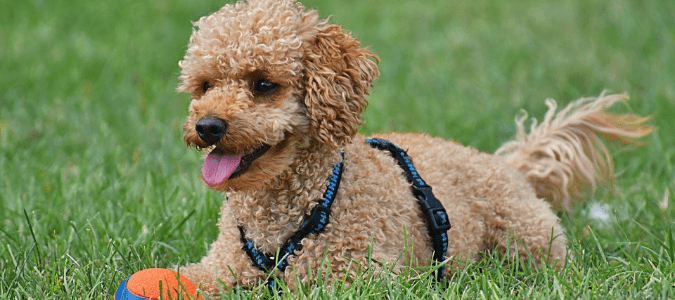
No matter the size or breed, dogs benefit from a good outdoor space. Your furry companion can get exercise and fresh air, and most breeds love having a dedicated area where they’re free to run around, chase toys and play. But homeowners have their own ideas about what makes an inviting and comfortable outdoor space. So what is the best grass for high traffic backyard dog owners?
The most resilient types of grass are Kentucky blue grass, perennial rye, Bermuda grass, tall fescue and Zoysia. While these grasses are tougher than most, keep in mind they are still at risk of getting trampled on and turning brown when subject to high traffic or other stresses.
If you’re considering replacing your grass with one of the species mentioned above, it is extremely important to look out for a grass that will grow well in your climate. For example, while Kentucky blue grass is hardy, it’s a cool-season grass, which means that is better suited to colder winter climates.
In addition to weather conditions, there are other factors you need to take into account when designing and maintaining a yard that meets both your and your pets’ needs. In this post, we will go into more detail on how to keep your lawn looking beautiful—even with active pets.
Let’s start off with how you can create a backyard that can withstand the demands of your pets.
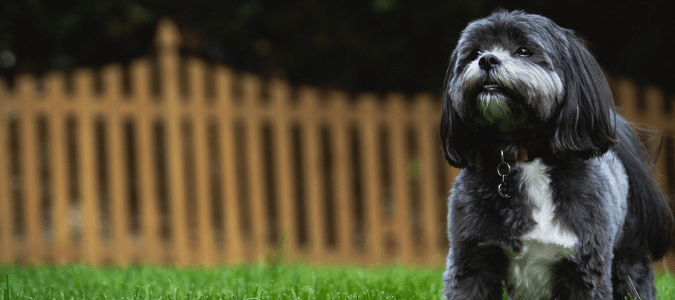
How To Create A Dog-Friendly Backyard
It is possible to have a dog, or even several dogs, and also a gorgeous yard. You may just need to make some minor adjustments to have a dog-friendly backyard.
Here are some ideas on how to keep both you and your pets happy in your outdoor spaces:
- Install fencing or another type of barrier to create a special area within your yard for your dog to run and urinate freely, away from more sensitive plants or landscape features.
- Use mulch to protect non-grassy parts of your lawn from foot and pet traffic and to reduce erosion. Be sure not to use cocoa bean mulch, however, as this variety is highly toxic to dogs. Use pine or cedar instead, and do not allow pets dig in or chew on mulch.
- Go outside with your dogs whenever they need to eliminate and spray those areas with water from a hose when your pet is finished. When you do this soon after a dog urinates, water will dilute the nitrogen content of the urine and disperse it over a larger area of the yard, making it less likely to cause damage.
- Similarly, make sure your dog drinks plenty of water throughout the day, since less concentrated urine is less likely to cause discoloration in grass.
- Keep up with the watering of your lawn in general, especially if you live in a hot or drought-prone area. Regular watering keeps grass healthy, allowing your turf to better handle other types of stress.
- Use fencing or other methods to keep your dog out of your compost pile, and avoid using chemicals in your lawn that could harm your pets.
- Instead of grass, install rocks, pebbles or decomposed granite as a hardy landscaping alternative so that your dog’s elimination and digging habits won’t have as much of an impact on the beauty of your outdoor space.
If you like the look of your grass and don’t want to fully convert to a hardscape, there are some grass types that are more resistant to your dogs’ “business”.
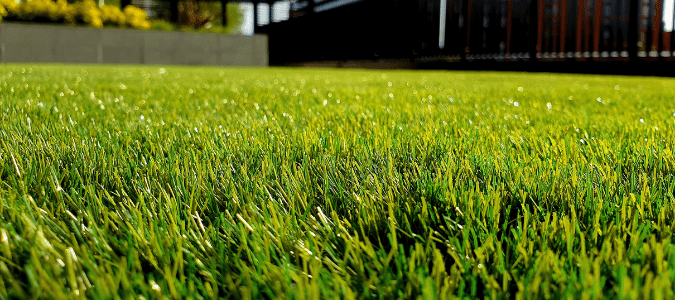
What Type Of Grass Is Most Resistant To Dog Urine?
Many homeowners wonder: Does dog pee kill grass? Some people believe that female dogs’ urine does more damage than that of male dogs, that certain dog breeds’ urine causes more damage than others or even that dietary supplements can change the composition of a dog’s urine and thereby protect the grass—but these are all myths.
Larger dogs do produce a larger volume of urine than smaller dogs, so a smaller dog might cause less damage to grass simply because it urinates less. Similarly, dogs that drink more water will have more diluted urine that won’t cause as much damage. For the most part, however, any dog’s urine can result in unsightly yellow or brown patches in an otherwise healthy lawn.
So, what type of grass is most resistant to dog urine? Here is a comprehensive list of common types of grass many homeowners consider for their yards, and how each one holds up to dog urine:
- Bermuda – A good choice for yards with low shade but high traffic and dogs doing their business.
- Fescue – There are many types of fescue grasses; all tend to be hardy and resistant to dog waste, and typically do well in shady yards.
- Zoysia – This hardy grass does well with moderate amounts of shade and high traffic, but may not tolerate dog urine well.
- St. Augustine – A good choice for shaded yards, but not for yards with high traffic from dogs.
- Perennial rye – This type of grass is highly tolerant of dog urine, and is also hardy even with lots of foot traffic from people and pets.
If you deal with a lawn that is suffering not only from heavy use from your pets, but also lack of sunshine, we can help you there too.
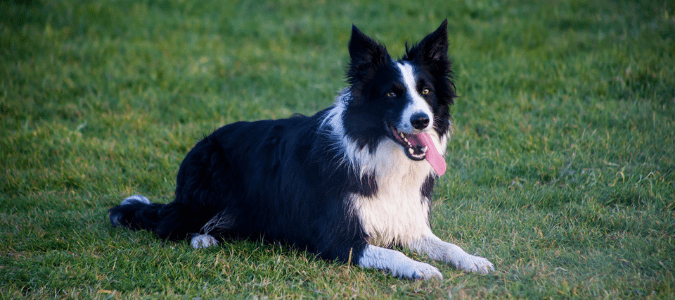
Best Grass For High Traffic And Shade
Homeowners who have shady backyards or lots of foot traffic might have more trouble than most with keeping a lush, green lawn, and might wonder about the best grass type. There are several varieties of grass that perform better than others under all types of stress and sub-optimal conditions, including traffic from pets and kids, exposure to dog urine and lots of shade from trees.
Zoysia grass is a very hardy variety that grows well in both warmer and colder regions. This grass type can tolerate light to moderate shade, but may not fare as well in complete shade. Zoysia is highly resistant to heavy traffic, and once established, is also very drought-tolerant. This type of grass can be a good choice for yards that sustain a lot of wear from active kids or pets, but homeowners with Zoysia who have dogs will still have to be careful about their dogs’ urine damaging the grass. This is because Zoysia grows slowly and develops a thick root structure over time, which can mean that dogs’ urine won’t drain away as easily as it would with another type of grass. Now if you’re wondering which Zoysia grass type is best for your lawn, you might consider Manila grass, Japanese lawngrass or Emerald Zoysia.
Bermuda grass is one of the best grass varieties for resisting dog urine, and it’s also fairly resilient when it comes to wear and tear from foot traffic. Bermuda grass needs plenty of sun, and it grows quickly, which increases maintenance needs—you may have to maintain Bermuda grass more often than if you had another variety.
St. Augustine grass is a traditional and popular choice among homeowners for its beautiful, lush appearance. However, this type of grass is not resistant to wear and tear or heavy traffic from an active family. You may also want to consider that St. Augustine does tolerate shade better than Zoysia or Bermuda grass. Ultimately, the type of grass you choose for your lawn depends on your family’s specific needs.
As mentioned previously, some homeowners choose to forgo grass in portions of their yard, or altogether, in favor of hardscaping—meaning, pathways and other areas consisting of rocks, patio pavers, pebbles or crushed granite that won’t be damaged by foot traffic or a dog doing its business. These options are also far hardier than any type of grass could ever be in terms of dogs’ digging behaviors.
But, if you’re hard set on keeping your grass, how can you best maintain it with active pets?
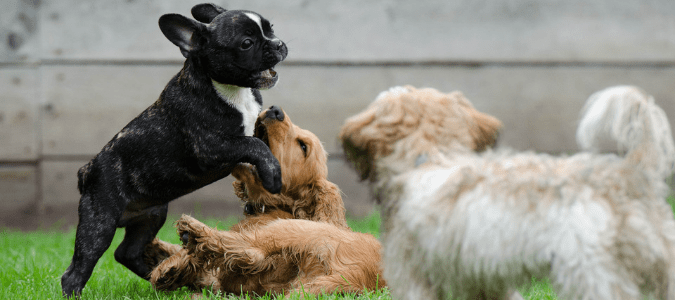
How To Keep Grass With Dogs
Homeowners wondering how to keep grass with dogs should know that wear and tear and urine aren’t the only potential problems that dogs can cause. Dogs’ feces also contain nitrogen that can harm grass, not to mention the fact that its bacteria content makes these waste products a potential health hazard. This is why it’s a good idea to clean up after your dog as often as possible, removing any waste materials so your yard stays clean and healthy—both for the aesthetics and the safety of everyone who spends time in your yard.
Therefore, the best ways to keep grass healthy and thriving with dogs around is to pick up your dog’s waste regularly, keep the grass well irrigated and provide the dog with a special “dog run” area, if needed, to preserve the rest of the grass. If fencing off an area isn’t a desirable option, you might choose instead to invest in training to help your dog learn to eliminate in only one area of the yard in order to make cleanup and maintenance easier.
Speaking of a professional, a dog trainer isn’t the only expert you may need.
ABC Can Keep Your Lawn Healthy And Green
Keeping up with lawn care can be a daunting prospect if you have a busy life and pets that seem intent on destroying your yard. ABC Home & Commercial Services can help you with all aspects of your landscape, no matter what demands you have for your yard or whether you get lots of shade or require any other special consideration. Our lawn experts are experienced in all types of lawn issues and concerns, and can handle everything from helping you plan a beautiful and functional outdoor space to putting in new grass and other plants to maintaining your outdoor space over time. Let us do the hard work so you can relax and enjoy your beautiful yard and lawn—and your pets can, too.
